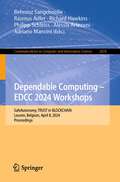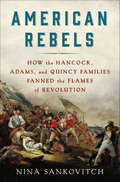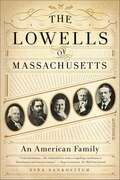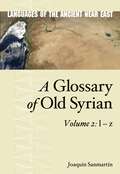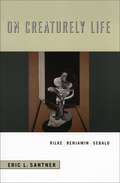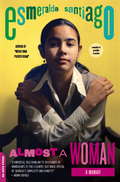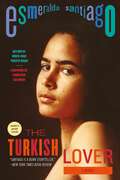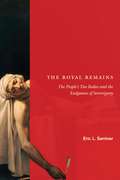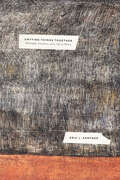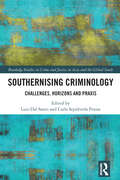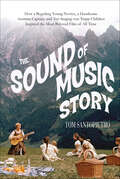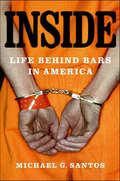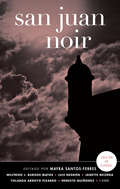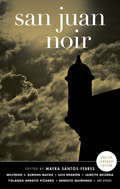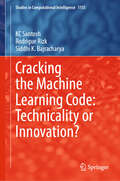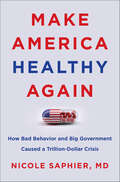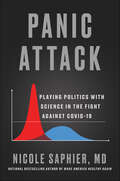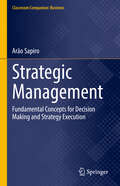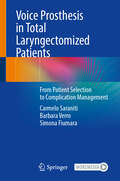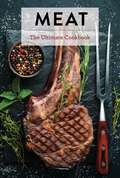- Table View
- List View
Dependable Computing – EDCC 2024 Workshops: SafeAutonomy, TRUST in BLOCKCHAIN, Leuven, Belgium, April 8, 2024, Proceedings (Communications in Computer and Information Science #2078)
by Behrooz Sangchoolie Rasmus Adler Richard Hawkins Philipp Schleiss Alessia Arteconi Adriano ManciniThis book constitutes the refereed proceedings of Workshops held at the 19th European Dependable Computing Conference, EDCC 2024: First Workshop on Safe Autonomous Systems, SafeAutonomy 2024, and the First Workshop on the Role of TRUST in the implementation of Digital Technologies: Blockchain Technology and Artificial Intelligence in Smart Cities, TRUST IN BLOCKCHAIN 2024. The 13 workshop papers presented in this book were thoroughly reviewed and selected from 14 submissions. The TRUST IN BLOCKCHAIN workshop accepted extended abstract submissions, whereas the SafeAutonomy workshop accepted regular technical papers, case studies, PhD forum papers, as well as position papers. They deal with latest research results on theory, techniques, systems, and tools for the design, validation, operationand evaluation of dependable and secure computing systems.
Toulanika Sarkara Mattu Rajakiya: ತೌಲಾನಿಕ ಸರ್ಕಾರ ಮತ್ತು ರಾಜಕೀಯ
by Ramesha Sankaraddyಇದು ತೌಲಾನಿಕ ಸರ್ಕಾರ ಮತ್ತು ರಾಜಕೀಯ ಮೂಲಭೂತ ಪರಿಕಲ್ಪನೆಗಳು 2021/22 ರಿಂದ ಜಾರಿಗೆ ಬಂದ ರಾಷ್ಟ್ರೀಯ ಶಿಕ್ಷಣ ನೀತಿಯ ಅಡಿಯಲ್ಲಿ ರಾಜ್ಯಶಾಸ್ತ್ರದ ಐದನೇ ಸೆಮಿಸ್ಟರ್ ವಿದ್ಯಾರ್ಥಿಗಳಿಗೆ ಸೂಚಿಸಲಾದ ಪಠ್ಯಕ್ರಮದ ಪ್ರಕಾರ ಕರ್ನಾಟಕದ ಎಲ್ಲಾ ವಿಶ್ವವಿದ್ಯಾಲಯಗಳಿಗೆ ಅನ್ವಯವಾಗುವಂತೆ ವಿನ್ಯಾಸಗೊಳಿಸಲಾದ ಪುಸ್ತಕವಾಗಿದೆ.
American Rebels: How the Hancock, Adams, and Quincy Families Fanned the Flames of Revolution
by Nina SankovitchNina Sankovitch’s American Rebels explores, for the first time, the intertwined lives of the Hancock, Quincy, and Adams families, and the role each person played in sparking the American Revolution.Before they were central figures in American history, John Hancock, John Adams, Josiah Quincy Junior, Abigail Smith Adams, and Dorothy Quincy Hancock had forged intimate connections during their childhood in Braintree, Massachusetts. Raised as loyal British subjects who quickly saw the need to rebel, their collaborations against the Crown and Parliament were formed years before the revolution and became stronger during the period of rising taxes and increasing British troop presence in Boston. Together, the families witnessed the horrors of the Boston Massacre, the Battles of Lexington and Concord, and Bunker Hill; the trials and tribulations of the Siege of Boston; meetings of the Continental Congress; transatlantic missions for peace and their abysmal failures; and the final steps that led to the signing of the Declaration of Independence.American Rebels explores how the desire for independence cut across class lines, binding people together as well as dividing them—rebels versus loyalists—as they pursued commonly-held goals of opportunity, liberty, and stability. Nina Sankovitch's new book is a fresh history of our revolution that makes readers look more closely at Massachusetts and the small town of Braintree when they think about the story of America’s early years.
The Lowells of Massachusetts: An American Family
by Nina SankovitchThe Lowells of Massachusetts were a remarkable family. They were settlers in the New World in the 1600s, revolutionaries creating a new nation in the 1700s, merchants and manufacturers building prosperity in the 1800s, and scientists and artists flourishing in the 1900s. For the first time, Nina Sankovitch tells the story of this fascinating and powerful dynasty in The Lowells of Massachusetts.Though not without scoundrels and certainly no strangers to controversy , the family boasted some of the most astonishing individuals in America’s history: Percival Lowle, the patriarch who arrived in America in the seventeenth to plant the roots of the family tree; Reverend John Lowell, the preacher; Judge John Lowell, a member of the Continental Congress; Francis Cabot Lowell, manufacturer and, some say, founder of the Industrial Revolution in the US; James Russell Lowell, American Romantic poet; Lawrence Lowell, one of Harvard’s longest-serving and most controversial presidents; and Amy Lowell, the twentieth century poet who lived openly in a Boston Marriage with the actress Ada Dwyer Russell.The Lowells realized the promise of America as the land of opportunity by uniting Puritan values of hard work, community service, and individual responsibility with a deep-seated optimism that became a well-known family trait. Long before the Kennedys put their stamp on Massachusetts, the Lowells claimed the bedrock.
A Glossary of Old Syrian: Volume 2: l – z (Languages of the Ancient Near East)
by Joaquin SanmartínA Glossary of Old Syrian: l–z is the second of two volumes that aim to map the lexicon of Old Syrian as it can be extracted and reconstructed from the (Old Akkadian) Eblaite through the Old and Middle Babylonian corpora.Referring to a continuum of dialects spoken in the Syrian-Levantine and Syrian-Mesopotamian regions through the third and second millennia BCE, “Old Syrian” is a diachronically conservative, geographically pluricentric, and pragmatically multilayered linguistic cluster. As such, the Glossary pays special attention to the distribution of lexical data along diachronic, diatopic, and diastratic criteria. Given the extent and widely dispersed nature of this data, entries are supported by the most representative corpora of the Old Syrian linguistic landscape. Each entry is headed by an etymon, a kind of prelinguistic consonantal skeleton, and further information about different lexemes, their roots, and their derivations is provided in subentries. As the lexicography of Old Syrian remains uncertain, the Glossary includes leading interpretative opinions alongside the most relevant Semitic material to corroborate the lexical choices it adopts. Bibliographical references are succinct and restricted, as a rule, to texts easily found in any Assyriological or Semitic library.Intended as a reference work in support of future study, A Glossary of Old Syrian offers a clear view of the state of the field.
A Glossary of Old Syrian: Volume 1: ʔ – ḳ (Languages of the Ancient Near East)
by Joaquin SanmartínA Glossary of Old Syrian: ʔ – ḳ is the first of two volumes aimed at the completion of a lexicographical index of the Old Syrian linguistical continuum. This glossary gives a picture, or map, of the Old Syrian lexicon as it can be extracted and reconstructed from the available sources, from the (Old Akkadian-)Eblatic through the Old and Middle Babylonian corpora.Old Syrian can be defined most appropriately as a diachronically conservative, geographically pluricentric, and pragmatically multilayered linguistic cluster. Therefore, the present work pays special attention to the distribution of lexical data along diatopic and diastratic criteria. In view of the enormous amount of material and the dispersion of the data, this glossary focuses on the most representative textual corpora of the Old Syrian linguistic landscape. The bibliographical references are kept deliberately succinct and as a rule, restricted to the classic works that may be easily found in every Assyriological or Semitic library, public or private, and that will redirect the users to their sources. Since the Old Syrian lexicography remains uncertain, the leading interpretative opinions are included alongside the most relevant comparative Semitic material. A Glossary of Old Syrian offers a clear picture of the current state of this field and is intended to serve as a reference work in support of future study.
Evidence
by Lucy SanteFollowing Low Life, Lucy Sante's acclaimed evocation of the underside of New York City's history, Evidence is an investigation into the mysteries of crime, death, and photography that only this brilliant and original writer could conduct.In one sense Evidence is a picture book - a collection of 55 evidence photographs taken by the New York City Police Department between 1914 and 1918. These are startling images, some brutal, some poetic, and all possessed of a strange and spectral beauty.Lucy Sante minutely examines these pictures of crime scenes and draws them out by every possible means: speculating about the lives and deaths depicted; discussing the progress of the forensic use of photographs and the mission of photography itself; and, where possible, reconstructing the events that led up to these frozen terminal images. Evidence is many things at once: aesthetic object, historical and sociological document, mystery novel, memento mori, and time machine.
On Creaturely Life: Rilke, Benjamin, Sebald
by Eric L. SanterIn his Duino Elegies, Rainer Maria Rilke suggests that animals enjoy direct access to a realm of being—the open—concealed from humans by the workings of consciousness and self-consciousness. In his own reading of Rilke, Martin Heidegger reclaims the open as the proper domain of human existence but suggests that human life remains haunted by vestiges of an animal-like relation to its surroundings. Walter Benjamin, in turn, was to show that such vestiges—what Eric Santner calls the creaturely—have a biopolitical aspect: they are linked to the processes that inscribe life in the realm of power and authority. Santner traces this theme of creaturely life from its poetic and philosophical beginnings in the first half of the twentieth century to the writings of the enigmatic German novelist W. G. Sebald. Sebald’s entire oeuvre, Santner argues, can be seen as an archive of creaturely life. For Sebald, the work on such an archive was inseparable from his understanding of what it means to engage ethically with another person’s history and pain, an engagement that transforms us from indifferent individuals into neighbors. An indispensable book for students of Sebald, On Creaturely Life is also a significant contribution to critical theory.
Almost a Woman: A Memoir (A Merloyd Lawrence Book)
by Esmeralda SantiagoFollowing the enchanting story recounted in When I Was Puerto Rican of the author&’s emergence from the barrios of Brooklyn to the prestigious Performing Arts High School in Manhattan, Esmeralda Santiago delivers the tale of her young adulthood, where she continually strives to find a balance between becoming American and staying Puerto Rican. While translating for her mother Mami at the welfare office in the morning, starring as Cleopatra at New York&’s prestigious Performing Arts High School in the afternoons, and dancing salsa all night, she begins to defy her mother&’s protective rules, only to find that independence brings new dangers and dilemmas.
The Turkish Lover: A Memoir (A Merloyd Lawrence Book)
by Esmeralda SantiagoEnthralled admirers of Esmeralda Santiago's memoirs of her childhood have yearned to read more. Now, in The Turkish Lover, Esmeralda finally breaks out of the monumental struggle with her powerful mother, only to elope into the spell of an exotic love affair. At the heart of the story is Esmeralda's relationship with "the Turk," a passion that gradually becomes a prison out of which she must emerge to become herself. The expansive humanity, earthy humor, and psychological courage that made Esmeralda's first two books so successful are on full display again in The Turkish Lover.
The Royal Remains: The People's Two Bodies and the Endgames of Sovereignty
by Eric L. Santner"The king is dead. Long live the king!" In early modern Europe, the king's body was literally sovereign—and the right to rule was immediately transferrable to the next monarch in line upon the king's death. In The Royal Remains, Eric L. Santner argues that the "carnal" dimension of the structures and dynamics of sovereignty hasn't disappeared from politics. Instead, it migrated to a new location—the life of the people—where something royal continues to linger in the way we obsessively track and measure the vicissitudes of our flesh. Santner demonstrates the ways in which democratic societies have continued many of the rituals and practices associated with kingship in displaced, distorted, and usually, unrecognizable forms. He proposes that those strange mental activities Freud first lumped under the category of the unconscious—which often manifest themselves in peculiar physical ways—are really the uncanny second life of these "royal remains," now animated in the body politic of modern neurotic subjects. Pairing Freud with Kafka, Carl Schmitt with Hugo von Hofmannsthal,and Ernst Kantorowicz with Rainer Maria Rilke, Santner generates brilliant readings of multiple texts and traditions of thought en route to reconsidering the sovereign imaginary. Ultimately, The Royal Remains locates much of modernity—from biopolitical controversies to modernist literary experiments—in this transition from subjecthood to secular citizenship. This major new work will make a bold and original contribution to discussions of politics, psychoanalysis, and modern art and literature.
Untying Things Together: Philosophy, Literature, and a Life in Theory
by Eric L. SantnerUntying Things Together helps to clarify the stakes of the last fifty years of literary and cultural theory by proposing the idea of a sexuality of theory. In 1905, Freud published his Three Essays on the Theory of Sexuality, the book that established the core psychoanalytic thesis that sexuality is central to formations of the unconscious. With this book, Eric L. Santner inverts Freud’s title to take up the sexuality of theory—or, more exactly, the modes of enjoyment to be found in the kinds of critical thinking that, since the 1960s, have laid claim to that ancient word, “theory.” Santner unfolds his argument by tracking his own relationship with this tradition and the ways his intellectual and spiritual development has been informed by it.Untying Things Together is both an intellectual history of major theoretical paradigms and a call for their reexamination and renewal. Revisiting many of the topics he has addressed in previous work, Santner proposes a new way of conceptualizing the eros of thinking, attuned to how our minds and bodies individually and collectively incorporate or “encyst” on a void at the heart of things. Rather than proposing a “return to theory,” Santner’s book simply employs theory as a way of further “(un)tying together” the resources of philosophy, art and literature, theology, psychoanalysis, political thought, and more.
Southernising Criminology: Challenges, Horizons and Praxis (Routledge Studies in Crime and Justice in Asia and the Global South)
by Luiz Dal Santo Carla Sepúlveda PennaThis book introduces the ‘Southern criminology’ movement; explores its theoretical, methodological, and philosophical tools; offers analytical accounts on the development of criminological thoughts in marginalised regions; and showcases the cutting edge of criminological research from Southern settings.Southernising Criminology is structured into three parts. The first part provides theoretical and methodological insights into how criminology can be Southernised, including renowned social scientists who share concerns for the need to reconceptualise the centre, the periphery, and their relations. The second part brings the reader up-to-date with the state of criminological research in different parts of the world and how far this landscape has changed when introducing Southern perspectives. The third part shows first-hand examples of how Southern criminology is done, with its challenges and transformative potential for criminological knowledge. Bringing together contributions from leading scholars working across the five continents and drawing on issues such as state criminality, violent crime, criminal justice practices, and state and non-state punishment, this book offers a critical account of the problems of metropolitan thinking, colonial and imperial power relations, and Western ethnocentric approaches to criminology. It offers a nuanced and grounded reflection on how things are being done differently and why that is important.An accessible and compelling read, this book will appeal to students and scholars of criminology, sociology, politics, and policy makers from around the world who are interested in the field of criminology and are aware of the urgent need for it to be decolonised and democratised.
Considering Doris Day: A Biography
by Tom SantopietroThe biggest female box office attraction in Hollywood history, Doris Day remains unequalled as the only entertainer who has ever triumphed in movies, radio, recordings, and a multi-year weekly television series. America's favorite girl next door may have projected a wholesome image that led Oscar Levant to quip "I knew Doris Day before she was a virgin," but in Considering Doris Day Tom Santopietro reveals Day's underappreciated and effortless acting and singing range that ran the gamut from musicals to comedy to drama and made Day nothing short of a worldwide icon. Covering the early Warner Brothers years through Day's triumphs working with artists as varied as Alfred Hitchcock and Bob Fosse, Santopietro's smart and funny book deconstructs the myth of Day as America's perennial virgin, and reveals why her work continues to resonate today, both onscreen as pioneering independent career woman role model, and off, as a recipient of the Presidential Medal of Freedom, the United States' highest civilian honor. Praised by James Cagney as "my idea of a great actor" and by James Garner as "the Fred Astaire of comedy," Doris Day became not just America's favorite girl, but the number one film star in the world. Yet after two weekly television series, including a triumphant five year run on CBS, she turned her back on show business forever. Examining why Day's worldwide success in movies overshadowed the brilliant series of concept recordings she made for Columbia Records in the '50s and '60s, Tom Santopietro uncovers the unexpected facets of Day's surprisingly sexy acting and singing style that led no less an observer than John Updike to state "She just glowed for me." Placing Day's work within the social context of America in the second half of the twentieth century, Considering Doris Day is the first book that grants Doris Day her rightful place as a singular American artist.
The Sound of Music Story: How a Beguiling Young Novice, a Handsome Austrian Captain, and Ten Singing von Trapp Children Inspired the Most Beloved Film of All Time
by Tom SantopietroOn March 2, 1965, "The Sound of Music" was released in the United States and the love affair between moviegoers and the classic Rodgers and Hammerstein musical was on. Rarely has a film captured the love and imagination of the moviegoing public in the way that "The Sound of Music" did as it blended history, music, Austrian location filming, heartfelt emotion and the yodeling of Julie Andrews into a monster hit. Now, Tom Santopietro has written the ultimate "Sound of Music" fan book with all the inside dope from behind the scenes stories of the filming in Austria and Hollywood to new interviews with Johannes von Trapp and others. Santopietro looks back at the real life story of Maria von Trapp, goes on to chronicle the sensational success of the Broadway musical, and recounts the story of the near cancellation of the film when the "Cleopatra" bankrupted 20th Century Fox. We all know that Julie Andrews and Christopher Plummer played Maria and Captain Von Trapp, but who else had been considered? Tom Santopietro knows and will tell all while providing a historian's critical analysis of the careers of director Robert Wise and screenwriter Ernest Lehman, a look at the critical controversy which greeted the movie, the film's relationship to the turbulent 1960s and the super stardom which engulfed Julie Andrews. Tom Santopietro's "The Story of 'The Sound of Music'" is book for everyone who cherishes this American classic.
Inside: Life Behind Bars in America
by Michael G. SantosAmerican jails and prisons confine nearly 13.5 million people each year, and it is estimated that 6 to 7 percent of the U.S. population will be confined in their lifetimes. Despite these disturbing numbers, little is known about life inside beyond the mythology of popular culture.Michael G. Santos, a federal prisoner nearing the end of his second decade of continuous confinement, has dedicated the last eighteen years to shedding light on the lives of the men warehoused in the American prison system. Inside:Life Behind Bars in America, his first book for the general public, takes us behind those bars and into the chaos of the cellblock. Capturing the voices of his fellow prisoners with perfect pitch, Santos makes the tragic--- and at times inspiring---stories of men from the toughest gang leaders to the richest Wall Street criminals come alive. From drug schemes, murders for hire, and even a prostitution ring that trades on the flesh of female prison guards, this book contains the never-before-seen details of prison life that at last illuminate the varied ways in which men experience life behind bars in America.
San Juan Noir (Akashic Noir #0)
by Mayra Santos-FebresLa capital de Puerto Rico entra la serie noir, editado por una de las autoras más conocidas de San Juan. “A welcomed addition to the publisher’s popular noir series, San Juan Noir has the distinction of being issued in two editions, English and Spanish, to more accurately reflect the Caribbean island’s bilingual culture. Editor Santos-Febres gathers a varied collection of stories she expects will ‘reveal a side of Puerto Rico otherwise obscured by the tourist trade and preconception.’” —NBC News Latino La serie noir ha hecho una marca fuerte en el Caribe con Havana Noir, Kingston Noir, Haiti Noir, y Trinidad Noir. Este volumen muestra el hecho que la isla del Puerto Rico no es totalmente playas arenosas y hoteles extravagantes. Mayra Santos-Febres es uno de los titanes literarios de la isla, y ella ha reclutado una lista estelar de compatriotas a contribuir. Cuentos nuevos por: Wilfredo J. Burgos Matos, Ernesto Quiñonez, Mayra Santos-Febres, José Rabelo, Luis Negrón, Yolanda Arroyo Pizarro, Ana María Fuster Lavín, Janette Becerra, Manolo Núñez Negrón, Tere Dávila, Edmaris Carazo, Alejandro Álvarez Nieves, Charlie Vázquez y Manuel A. Meléndez.
San Juan Noir (Akashic Noir #0)
by Mayra Santos-FebresPuerto Rico's capital city enters the Noir Series arena, meticulously edited by one of San Juan's best-known authors. “A welcomed addition to the publisher’s popular noir series, San Juan Noir has the distinction of being issued in two editions, English and Spanish, to more accurately reflect the Caribbean island’s bilingual culture. Editor Santos-Febres gathers a varied collection of stories she expects will ‘reveal a side of Puerto Rico otherwise obscured by the tourist trade and preconception.’” —NBC News Latino Akashic Books continues its groundbreaking series of original noir anthologies, launched in 2004 with Brooklyn Noir. Each story is set in a distinct neighborhood or location within the city of the book. Brand-new stories by: Wilfredo J. Burgos Matos, Ernesto Quiñonez, Mayra Santos-Febres, José Rabelo, Luis Negrón, Yolanda Arroyo Pizarro, Ana María Fuster Lavín, Janette Becerra, Manolo Núñez Negrón, Tere Dávila, Edmaris Carazo, Alejandro Álvarez Nieves, Charlie Vázquez, and Manuel A. Meléndez. Translated by Will Vanderhyden.
Cracking the Machine Learning Code: Technicality or Innovation? (Studies in Computational Intelligence #1155)
by KC Santosh Rodrigue Rizk Siddhi K. BajracharyaEmploying off-the-shelf machine learning models is not an innovation. The journey through technicalities and innovation in the machine learning field is ongoing, and we hope this book serves as a compass, guiding the readers through the evolving landscape of artificial intelligence. It typically includes model selection, parameter tuning and optimization, use of pre-trained models and transfer learning, right use of limited data, model interpretability and explainability, feature engineering and autoML robustness and security, and computational cost – efficiency and scalability. Innovation in building machine learning models involves a continuous cycle of exploration, experimentation, and improvement, with a focus on pushing the boundaries of what is achievable while considering ethical implications and real-world applicability. The book is aimed at providing a clear guidance that one should not be limited to building pre-trained models to solve problems using the off-the-self basic building blocks. With primarily three different data types: numerical, textual, and image data, we offer practical applications such as predictive analysis for finance and housing, text mining from media/news, and abnormality screening for medical imaging informatics. To facilitate comprehension and reproducibility, authors offer GitHub source code encompassing fundamental components and advanced machine learning tools.
Make America Healthy Again: How Bad Behavior and Big Government Caused a Trillion-Dollar Crisis
by Nicole SaphierNATIONAL BESTSELLER!If Americans want to know why their health care is so costly and getting costlier, they need only look in the mirror.Americans are notoriously unhealthy—we eat too much, drink too much, and sit too much. When roughly 80 percent of cardiovascular disease and 40 percent of all cancer cases could be prevented by simple lifestyle changes, it is time to take a deeper look at the problem and ask who is truly responsible. Consider that: · After seventy years of innovation, heart disease and cancer remain the top two causes of death in the United States.· In 1960, health care spending was 5 percent of America's GDP; today, it is 17.5 percent.· The government spends over $1 trillion annually on health care.· Nearly one in five American deaths is associated with poor diets.· Simply reducing sodium intake by 1,200 mg per day could save up to $20 billion a year in medical costs. In Make America Healthy Again, Nicole Saphier, a Memorial Sloan Kettering physician, nationally recognized patient advocate, and media personality, reveals how individual negligence and big government incompetence have destroyed America’s health care system. Combining historical events, economic trends, and essential lifestyle advice, with her unique perspective, she offers concrete solutions to address this epic problem.We don’t need socialized medicine—we need to take better care of ourselves. By getting healthier and adopting preventative measures, Saphier believes, we can reduce the astronomical costs of treatment and improve overall care. The only way to lower medical costs for everyone is to stop incentivizing bad health decisions. Policies such as the Affordable Care Act and single-payer plans ignore something crucial to lowering the overall financial burden: personal responsibility. We can no longer expect doctors and the government to fix illnesses we have the power to prevent. Regardless of which health policy is adopted, our nation will flounder unless we take action. It is up to the American people to make America healthy again.
Panic Attack: Playing Politics with Science in the Fight Against COVID-19
by Nicole Saphier“Follow the science” is what they said. “Follow our politics” is what they meant. In Panic Attack, nationally bestselling author and physician Nicole Saphier uncovers the hypocrisy and hysteria which has characterized so much of the American pandemic response. While journalists trumpeted the importance of following science to “flatten the curve,” they praised Governors Andrew Cuomo and Phil Murphy, who sanctioned ill-equipped nursing homes to take COVID-positive patients, leading to an enormous death spike for New York and New Jersey. Plus, the old guard medical establishment captured by Dr. Fauci proved to be far too rigid during a health care emergency. While some state legislators are still concealing accurate records of nursing home deaths, many others have made anti-science decisions regarding re-opening plans; all of which fuel distrust and civil unrest. Democrat mayors like Bill de Blasio openly admitted that their decisions to keep schools closed were fueled by a “social contract” with teachers (that is: teachers’ unions), despite hard science saying this would be harmful.When anti-science measures are continuously implemented, the long-term consequences of such actions will likely stay with us for years to come. The pandemic has resulted in a failure of government, much of which is unavoidable in a unique disaster scenario. However, the rampant politicization of science, from the origin of the virus to the simple concept of wearing facemasks, has hopelessly muddied the water, divided the country, and knee-jerk anti-Trumpism made it all worse.
Strategic Management: Fundamental Concepts for Decision Making and Strategy Execution (Classroom Companion: Business)
by Arão SapiroThis book provides students with the fundamental concepts and stages of strategic management and planning in organizations with essential tools to make decisions in order to remain competitive in the business world of today. It offers an introduction to the key topics and themes of organizational and competitive strategies and provides a panoramic view of the changing corporate environment. The author draws on insights from various typical functional courses, such as marketing, finance, and accounting, to help students understand how top executives and managers make the strategic decisions that drive successful businesses. Students learn how to conduct a case analysis, measure organizational performance, and conduct external and internal analyses. The book features learning objectives, glossaries, and real cases related to the content of each chapter. The book also features discussions on the execution and evaluation of organizational performance; environment,social, and governance (ESG); and decision and risk analysis. This book is useful for upper undergraduate and graduate level courses in strategic planning and management, business administration, decision making, and business strategy.
New Welfare Policy and Democratic Politics in India (ISSN)
by Prakash SarangiNew Welfare Policy and Democratic Politics in India offers an analysis of India’s welfare policy during the last couple of decades. It looks at how welfare policy making is viewed as a function of party competition and voter mobilization, showing a gradual transformation of political clients into entitled citizens through which democratic politics in India has redefined its contemporary welfare discourse.The book argues that political parties formulate policies in order to respond to the voices of citizens and shows that a new welfare architecture emerged in India, characterized as responsive welfare. India has witnessed a sharp rise in such voices, which have been disadvantaged by a globalizing market. The size and vulnerability of this group has made them politically significant and electorally salient. These welfare aspirants have found a new political space through political parties to negotiate and assert their claims on the state, creating a milestone in India’s democratic politics trajectory, in the form of entitlement-based welfare policy. The book compares and evaluates the implications of these new welfare policies in the contexts of two governments: the Congress-led government during 2009-2014 and the BJP-led government during 20014-2019. The empirical data reveal remarkable similarities in their electoral pledges, policy outputs, policy outcomes and accountability towards citizens. These findings indicate significant convergence in their welfare policies, sans ideology or ethnic support base. It also reveals that the ideological differences among the two major parties do not prevent remarkable continuities in the formulation and implementation of welfare policies during their incumbencies, thus allowing for a bipartisan acceptance of a citizen-centric welfare policy.Offering a new analysis to understand this citizen-party-policy linkage in the formulation of welfare policy in India, the book presents a macro analysis of India’s interface between democratic politics and welfare policy. It will be of interest to researchers in the fields of the politics of welfare, democratisation in changing societies, comparative politics and Indian and South Asian Studies and Asian Politics.
Voice Prosthesis in Total Laryngectomized Patients: From Patient Selection to Complication Management
by Carmelo Saraniti Barbara Verro Simona FiumaraThe volume offers a comprehensive overview of voice rehabilitation after total laryngectomy through a multidisciplinary approach which is the result of the collaboration between otolaryngology specialists and speech therapists. After a short introduction on total laryngectomy and voice recovery, the volume discusses patient selection for voice prosthesis. The following part describes the surgical steps for prosthesis implantation and replacement, the complications that may occur and their solutions. The fourth part focuses on voice rehabilitation. The closing part reviews the different types of voice prostheses and devices and their use and correct management for optimal respiratory, olfactory and speech rehabilitation. Each topic addressed is supported by a wealth of detailed images and step-by-step videos. Given its features, the volume will be an invaluable tool for ENT specialists and speech therapists as well as residents in these fields.
Meat: The Ultimate Cookbook (Ultimate Cookbooks)
by Keith SarasinMeat: The Ultimate Cookbook is the definitive guide to preparing meat.What is better than that first bite of a succulent steak prepared to perfection as a rush of dopamine overcomes your senses? Meat has been part of every culture since we learned to hunt. Competitions have ensued to determine who has the best meat recipe around. Many parties find attendees hanging out around grills waiting for the perfect main course to be ready.This is the only cookbook the omnivore in your life will need, and inside you will find: Over 300 mouthwatering, internationally inspired easy-to-follow meat recipesChapters designed specifically for beef, pork, lamb, goat, wild game (like venison), and poultryGorgeous original photography that brings the recipes to lifeInterviews with notable farmers and chefsButchering techniquesA guide to brines, rubs, and saucesSides, salads, and accompaniments that take your meat to the next levelNo matter if you are using the oven, grill, Dutch oven, or a skillet, chef and restaurateur Keith Sarasin details how best to respect the hard work and energy required to bring meat from the fields to the table.
